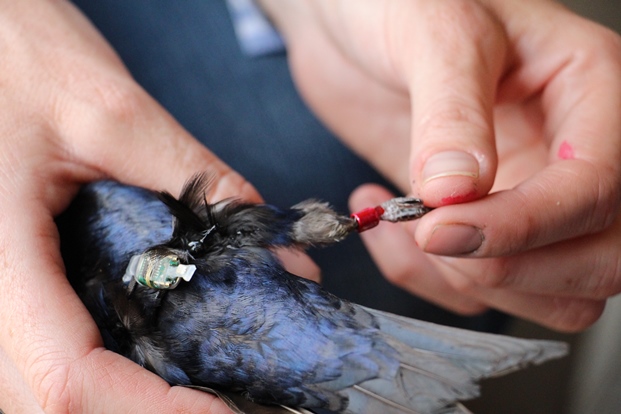Wild Pantex – Songbirds, Satellites, and the Tiniest of Technologies
Article by Jim Ray, Pantex Wildlife Biologist/Scientist
As mind-boggling as it may seem, as of this writing 13 adult songbirds are currently drifting southward, if not already soaring over the mighty Amazon River basin…with tiny GPS units strapped to their topsides. This is the first year that this technology has produced a unit small enough to be worn by such a small bird. An additional 12 birds sport a different kind of backpack, one that measures light-levels, only to be later converted by a computer program to a longitude and latitude, thus, like the GPS units, pinpoint locations of the birds as they make the roundtrip from a breeding site in Randall County to wintering areas in Brazil.
Although part of a larger partnership and research endeavor led by York University (Toronto, Canada), the University of Manitoba (Winnipeg, Canada), and the Purple Martin Conservation Association, the inclusion of Texas Panhandle birds in the range-wide study in 2013 and 2014 was made possible by Pantex – thanks to the commitment to the conservation of migratory birds displayed by the U. S. Department of Energy/National Nuclear Security Administration in cooperation with Consolidated Nuclear Security, LLC. An Executive Order and Memorandum of Understanding between the agencies and the U. S. Fish and Wildlife Service guides that conservation.
The subject bird is the Purple Martin (Progne subis), which is the largest swallow species in North America. The eastern subspecies, which is distributed east of the Rocky Mountains, nests almost exclusively in man-supplied bird housing. This and the fact that it is most apt to nest in such housing that is situated among human habitations, golf courses, and other such places, makes the bird a great subject for study. Much of what can be learned from the easily accessible Purple Martin, can tell us volumes about the migratory and wintering habits of other, much harder-to-study songbirds with similar life histories. Many of these are declining in population, as is the Purple Martin within some portions of its range of distribution.
2013
You may recall the news and social media reports on our deployment of geolocators that took place last year: See: Pantex Gets Hands on With Purple Martins, NNSA Blog, and Wildcat Bluff Blog. Those birds departed from the colony in early August to points unknown.
2014
In mid-February, individuals began to make their appearance again back at their colony site. Then, came a little bad luck. A family down the street with a large colony of Purple Martins moved away and took their martin housing with them. These birds, finding their nesting cavities missing, rapidly started filling in the available cavities at our study colony. This is normally a good problem to have!
However, we needed room for all of those returning geolocators! I ordered and put up more housing as fast as I could to try to make room for any geolocator-marked bird that had yet to secure a cavity or arrive from South America. I had new gourd bird houses hanging on the basketball goal, on the old swing set, and I erected 12 more on a fancy pole system out behind the house. These all filled up rapidly with pairs, but only eight geolocators were retrieved, which is a lower rate of return than what you would normally expect.
York University collaborators are currently analyzing our data, which I will share once the information gets published. However, I will say this. Preliminary data indicates that our birds and, to a lesser extent, those of a site at Corpus Christi –also on the western edge of the range—will be pointed out as being “different” in one aspect of their migration than those from all of the other study sites which are scattered from Alberta to Florida. In addition, there are a couple of other revelations that will be worth mentioning.
Oh, and next year the GPS backpacks which have a much higher accuracy, may be able to pinpoint the various trees or other structures that these birds are utilizing while away from our area. Stay tuned!

An adult male Purple Martin with a geolocator and band painted red to make it easier to be “picked out” among the other birds in the colony as being just released or needing recaptured.
